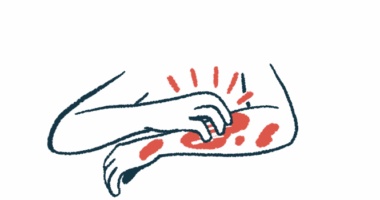How we manage the itching caused by my son’s liver disease
For us, cholestatic pruritus is one of the most difficult symptoms of Alagille

I don’t exactly love any of the symptoms my son Finley experiences because of Alagille syndrome, but the dreaded itch wears on me the most.
You cannot see his heart murmur. You can tell he’s smaller than his peers because of growth challenges related to his liver diseases, but that doesn’t currently affect his day-to-day life. He has some of the Alagille syndrome facial characteristics, but those are part of what makes Finley unique and special.
But the itch? You can see the itch, especially when you know the signs. It may not look like much to an uninformed onlooker. A quick scratch at the ankles, shuffling his T-shirt from side to side, or rubbing his feet against the couch or ground may look like fidgeting, but we know the truth. Itching, also known as cholestatic pruritus, is rearing its ugly head.
As a caregiver, I’m fully aware than I’m only somewhat in control here. Finley takes medication that’s greatly improved his quality of life. He sleeps better at night and scratches less throughout the day. Taking medication for pruritus is a great start, but we’ve relied on many other pieces to help us solve the itchiness puzzle.
How we help
Here are a few important ways we mitigate Finley’s itch:
- Loose cotton clothing: That’s a must. We look for comfortable clothes that won’t contribute to the itch and are picky about the fabrics we buy for Finley.
- Onesie pajamas: Although he’s grown out of onesies, they were essential when he was little. Our goal was to minimize the amount of skin available for him to scratch at night. We also made sure to stick to cotton pajamas. The fleece ones are supercute, but the warmer he gets, the more he itches.
- Running a gentle fan at bedtime: We keep a fan near Finley’s bed that has a low setting, which helps keep him cool and reduce his itch at night. Also, air conditioning was a nonnegotiable addition to our house.
- Unscented lotion: This item is an essential, especially after a bath, which can dry out his skin. Applying lotion to his whole body in the evening helps lessen his itch.
- Redirection: This one is hard to explain to a small child, but when I see him scratching with his nails, I try to redirect him to rub the area instead. Subtle hints are about all I can do, but hopefully he’ll understand someday that rubbing the area can be effective but less damaging. Distractions prove helpful as well.
These are just a few of the tactics that have helped us, most of which we learned from other families raising Alagille warriors. The more we share resources and experiences, the better off we’ll be. While I wish no one had to experience cholestatic pruritus, I’m grateful there are medications and methods to address it.
Note: Liver Disease News is strictly a news and information website about the disease. It does not provide medical advice, diagnosis, or treatment. This content is not intended to be a substitute for professional medical advice, diagnosis, or treatment. Always seek the advice of your physician or other qualified health provider with any questions you may have regarding a medical condition. Never disregard professional medical advice or delay in seeking it because of something you have read on this website. The opinions expressed in this column are not those of Liver Disease News or its parent company, Bionews, and are intended to spark discussion about issues pertaining to liver disease.








Leave a comment
Fill in the required fields to post. Your email address will not be published.